Study on the Strengthening Mechanism of Rare Earth Ce in Magnesium Alloys, Based on First-Principle Calculations and Electronegativity Theory
Abstract
:1. Introduction
2. Experimental and First-Principle Calculation Details
3. First-Principle Calculation of the Rare Earth Phases
4. Results and Discussion
4.1. Effect of Ce on the Microstructure and Compositions of Magnesium Alloys
4.2. The Effect of Ce on the Mechanical Properties of Magnesium Alloys
4.3. The Strengthening Mechanism of Ce in the Magnesium Alloy of Mg-Al Series
- (1)
- Between 750 °C and 641 °C: According to the research results of Qiang Yang [55], Al10Ce2Mn7 was transformed from Al8CeMn4. Gil Coury [53] confirmed that the two Al atoms in Al10CeMn2 were replaced by Mn atoms and converted into Al8CeMn4, which were observed using the TEM method, with both of them having similar properties and the melting point of Al8CeMn4 being 1191 °C. F. G. Coury [69] found that Al8CeMn4 was more likely to form at the Al-rich corner in Al-Mn-Ce ternary alloys, which was similar to the situation in this paper. The phase diagram calculations of Y. Yang [70] showed that Al10CeMn2 was transformed at 738 °C and 700 °C. Therefore, it could be inferred that the formation temperature of Al8CeMn4 (which could be converted into Al10Ce2Mn7) was also around 700 °C. Combined with electronegativity theory, it was suggested that the Al10Ce2Mn7 phase was preferentially formed from Al, Ce, and Mn elements, and solidified and dispersed at about 700 °C, when the matrix magnesium alloy was still in a liquid state. However, more specific formation temperatures and forming theories have rarely been reported [38,41], and need further study.
- (2)
- Between 641 °C and 436 °C: The liquidus of magnesium alloy was about 650 °C, and the Al11Ce3 was precipitated through a eutectic reaction LiqAl11Ce3+α-Al at 641 °C [42]. However, the preferentially precipitated Al10Ce2Mn7 and Al11Ce3 phases could not act as the nucleation particles of α-Mg, according to the mismatch calculations results. Therefore, the precipitated Al11Ce3 and Al10Ce2Mn7 phases adhered to the α-Mg surface and were distributed along the grain boundary, which inhibited the growth of the primary α-Mg grains, thus achieving the effect of grain refinement. Whereas, the Ce content was less than 1 wt.%, the Al element in the matrix alloy was sufficient to fully alloy with Ce, and the residual Al then further alloyed with Mg, following the order in electronegativity theory.
- (3)
- Between 436 °C and ambient temperature: the typical Mg17Al12 was generated at 436 °C through an eutectic reaction LiqMg17Al12+α-Mg [47]. Since Al10Ce2Mn7 and Al11Ce3 had already been distributed along the grain boundary at this temperature, this blocked the Mg17Al12 from forming a network/continuous morphology. Therefore, the precipitated Mg17Al12 phase after the addition of Ce was mainly in the shape of islands or clumps at the grain boundary, and a mixed strengthening structure of rare earth phase and conventional phase was formed. As a matter of fact, the melting point of Mg17Al12 was only 467 °C, whereas the melting point of Al10Ce2Mn7 and Al11Ce3 was above 1000 °C [43,50,55]. In addition, the Ce-containing rare earth phase was not solid soluble in magnesium, and the heat resistance and high temperature strength of the magnesium alloy were significantly improved by adding an appropriate amount of Ce. However, with the increased addition of Ce, a large amount of conventional alloying elements (Mn, Al, Zn, etc.) were consumed. As a result, the strengthening phases in the magnesium alloy gradually changed from a mixed strengthening structure of rare earth and conventional precipitated phases to a single rare earth phase structure. However, the acicular Al11Ce3 phase was not fused with the magnesium matrix, which generated stress and formed microcracks. Therefore, excessive Ce element addition reduces the mechanical properties of an alloy.
5. Conclusions
- (1)
- The first-principle calculation results showed that the formation enthalpy and cohesive energy of the Al-Ce series phase were much higher than that of the Mg-Al and Mg-Ce series phases in a Mg-Al-Ce ternary alloy system, which meant that Ce would preferentially alloy with Al element to form Al-Ce phase. While Mg-Al phase and Mg-Ce phase would be formed in sequence when the Ce was completely consumed. The calculation results were highly consistent with electronegativity theory.
- (2)
- The microstructure and composition analyses of the alloy found that the strengthening phase of magnesium alloy after adding Ce element was mainly needle-like Al11Ce3; rod-like Al10Ce2Mn7, which was distributed at the grain boundary and through the grains; and Mg17Al12 phase, which was broken into granular or island shapes at the grain boundary. In combination with mismatch theory, it was proven that the preferentially precipitated Al11Ce3 and Al10Ce2Mn7 phases could not act as the nucleation core of α-Mg, but instead were precipitated at the grain boundary, thereby blocking the continuous distribution of Mg17Al12. While, a reinforced structure was formed, with the rare earth phase mixed with conventional phase.
- (3)
- The tensile results at ambient temperature and high temperature showed that a strengthened structure of rare earth phase mixed with conventional strengthening phase was beneficial for improving the comprehensive mechanical properties of magnesium alloys, by adding an appropriate amount of Ce element; with the appropriate Ce addition range being 0.2–0.4 wt %. After adding an excessive amount of Ce element, the strengthening phase of the alloy was mainly Al11Ce3. While, the acicular Al11Ce3, which did not fuse with the matrix, easily became the source of cracking, due to the stress concentration, and reduced the mechanical properties of the alloy.
- (4)
- Combined with electronegativity theory, the mechanism of the microstructural evolution of a Mg-Al-Zn-Ce-Mn multi-elements alloy during solidification was simplified, with temperature as the dimension, and the strengthening mechanism of Ce element in magnesium alloys was deduced.
Author Contributions
Funding
Institutional Review Board Statement
Informed Consent Statement
Data Availability Statement
Acknowledgments
Conflicts of Interest
References
- Fu, S.; Li, Q.; Jing, X.; Zhang, Q.; Chen, Z.; Liu, W. Review on Research and Development of Heat Resistant Magnesium Alloy; Atlantis Press: Paris, France, 2012; pp. 682–685. [Google Scholar]
- Jiao, F.W.; Jin, L.; Dong, J.; Wang, F.H. In situ electron backscatter diffraction analysis for microstructure evolution and deformation models of Mg-Ce alloy during uniaxial loading. Acta Metall. Sin. (Engl. Lett.) 2019, 32, 263–268. [Google Scholar] [CrossRef] [Green Version]
- Zhang, C.; Han, P.; Yan, X.; Wang, C.; Xia, L.; Xu, B. First-principles study of typical precipitates in creep resistant magnesium alloys. J. Phys. D Appl. Phys. 2009, 42, 125403. [Google Scholar] [CrossRef]
- Pekguleryuz, M.; Celikin, M. Creep resistance in magnesium alloys. Int. Mater. Rev. 2010, 55, 197–217. [Google Scholar] [CrossRef]
- Mordike, B.L.; Ebert, T. Magnesium: Properties-applications-potential. Mater. Sci. Eng. A 2001, 302, 37–45. [Google Scholar] [CrossRef]
- Pekguleryuz, M.O.; Kaya, A.A. Creep resistant magnesium alloys for powertrain applications. Adv. Eng. Mater. 2003, 5, 866–878. [Google Scholar]
- Wu, G.; Wang, C.; Sun, M.; Ding, W. Recent developments and applications on high-performance cast magnesium rare-earth alloys. J. Magnes. Alloys. 2020, 9, 1–20. [Google Scholar]
- Zhang, J.; Liu, S.; Wu, R.; Hou, L.; Zhang, M. Recent developments in high-strength Mg-RE-based alloys: Focusing on Mg-Gd and Mg-Y systems. J. Magnes. Alloys. 2018, 6, 277–291. [Google Scholar] [CrossRef]
- Luo, Q.; Guo, Y.; Liu, B.; Feng, Y.; Zhang, J.; Li, Q.; Chou, K. Thermodynamics and kinetics of phase transformation in rare earth–magnesium alloys: A critical review. J. Mater. Sci. Technol. 2020, 44, 171–190. [Google Scholar]
- Wang, B.; Liu, C.; Gao, Y.; Jiang, S.; Chen, Z.; Luo, Z. Microstructure evolution and mechanical properties of Mg-Gd-Y-Ag-Zr alloy fabricated by multidirectional forging and ageing treatment. Mater. Sci. Eng. A 2017, 702, 22–28. [Google Scholar] [CrossRef]
- Ding, Z.B.; Zhao, Y.H.; Lu, R.P.; Yuan, M.N.; Wang, Z.J.; Li, H.J.; Hua, H.O. Effect of Zn addition on microstructure and mechanical properties of cast Mg-Gd-Y-Zr alloys. Trans. Nonferrous Met. Soc. China 2019, 29, 722–734. [Google Scholar] [CrossRef]
- Wang, Y.; Zhang, F.; Wang, Y.; Duan, Y.; Wang, K.; Zhang, W.; Hu, J. Effect of Zn content on the microstructure and mechanical properties of Mg-Gd-Y-Zr alloys. Mater. Sci. Eng. A 2019, 745, 149–158. [Google Scholar] [CrossRef]
- Lyu, S.; Xiao, W.; Li, G.; Zheng, R.; Ma, C. Achieving enhanced mechanical properties in Mg-Y-Sm-Zr alloy by altering precipitation behaviors through Zn addition. Mater. Sci. Eng. A 2019, 746, 179–186. [Google Scholar] [CrossRef]
- Liu, N.; Zhang, Z.; Peng, L.; Ding, W. Microstructure evolution and mechanical properties of Mg-Gd-Sm-Zr alloys. Mater. Sci. Eng. A 2015, 627, 223–229. [Google Scholar] [CrossRef]
- Zheng, K.Y.; Dong, J.; Zeng, X.Q.; Ding, W.J. Precipitation and its effect on the mechanical properties of a cast Mg-Gd-Nd-Zr alloy. Mater. Sci. Eng. A 2008, 489, 44–54. [Google Scholar] [CrossRef]
- Liu, X.B.; Chen, R.S.; Han, E.H. Effects of ageing treatment on microstructures and properties of Mg-Gd-Y-Zr alloys with and without Zn additions. J. Alloys Compd. 2008, 465, 232–238. [Google Scholar] [CrossRef]
- Li, D.J.; Zeng, X.Q.; Jie, D.O.; Zhai, C.Q. Influence of heat treatment on microstructure and mechanical properties of Mg-10Gd-3Y-1.2 Zn-0.4Zr alloy. Trans. Nonferrous Met. Soc. China 2008, 18, s117–s121. [Google Scholar]
- Li, J.; He, Z.; Fu, P.; Wu, Y.; Peng, L.; Ding, W. Heat treatment and mechanical properties of a high-strength cast Mg-Gd-Zn alloy. Mater. Sci. Eng. A 2016, 651, 745–752. [Google Scholar] [CrossRef]
- Yamada, K.; Hoshikawa, H.; Maki, S.; Ozaki, T.; Kuroki, Y.; Kamado, S.; Kojima, Y. Enhanced age-hardening and formation of plate precipitates in Mg-Gd-Ag alloys. Scr. Mater. 2009, 61, 636–639. [Google Scholar] [CrossRef]
- Zhang, Y.; Rong, W.; Wu, Y.; Peng, L.; Nie, J.-F.; Birbilis, N. A comparative study of the role of Ag in microstructures and mechanical properties of Mg-Gd and Mg-Y alloys. Mater. Sci. Eng. A 2018, 731, 609–622. [Google Scholar] [CrossRef]
- Gao, X.; Nie, J.F. Enhanced precipitation-hardening in Mg-Gd alloys containing Ag and Zn. Scr. Mater. 2008, 58, 619–622. [Google Scholar] [CrossRef]
- Nie, J.F. Precipitation and hardening in magnesium alloys. Mater. Sci. Eng. A 2012, 43, 3891–3939. [Google Scholar]
- Liu, W.; Zhou, B.; Wu, G.; Zhang, L.; Peng, X.; Cao, L. High temperature mechanical behavior of low-pressure sand-cast Mg-Gd-Y-Zr magnesium alloy. J. Magnes. Alloys 2019, 7, 597–604. [Google Scholar] [CrossRef]
- Imandoust, A.; Barrett, C.D.; Oppedal, A.L.; Whittington, W.R.; Paudel, Y.; El Kadiri, H. Nucleation and preferential growth mechanism of recrystallization texture in high purity binary magnesium-rare earth alloys. Acta Mater. 2017, 138, 27–41. [Google Scholar] [CrossRef]
- Yan, Z.; Fang, M.; Lian, Z.; Zhang, Z.; Zhu, J.; Zhang, G.; Wang, Y. Research on AZ80 + 0.4% Ce (wt%) ultra-thin-walled tubes of magnesium alloys: The forming process, microstructure evolution and mechanical properties. Metals 2019, 9, 563. [Google Scholar] [CrossRef] [Green Version]
- Kondori, B.; Mahmudi, R. Effect of Ca additions on the microstructure, thermal stability and mechanical properties of a cast AM60 magnesium alloy. Mater. Sci. Eng. A 2010, 527, 2014–2021. [Google Scholar] [CrossRef]
- Hirai, K.; Somekawa, H.; Takigawa, Y.; Higashi, K. Effects of Ca and Sr addition on mechanical properties of a cast AZ91 magnesium alloy at room and elevated temperature. Mater. Sci. Eng. A 2005, 403, 276–280. [Google Scholar] [CrossRef]
- Wang, M.; Xiao, D.H.; Liu, W.S. Effect of Si addition on microstructure and properties of magnesium alloys with high Al and Zn contents. Vacuum 2017, 141, 144–151. [Google Scholar] [CrossRef]
- Marjani, O.; Emamy, M.; Mirzadeh, H. Mechanical behavior of as-cast and extruded Mg-Si-Ni-Ca magnesium alloys. J. Mater. Eng. Perform. 2020, 29, 7728–7735. [Google Scholar] [CrossRef]
- Jing, B.; Sun, Y.; Xun, S.; Xue, F.; Zhu, T. Microstructure and tensile creep behavior of Mg-4Al based magnesium alloys with alkaline-earth elements Sr and Ca additions. Mater. Sci. Eng. A 2006, 419, 181–188. [Google Scholar]
- Afsharnaderi, A.; Lotfpour, M.; Mirzadeh, H.; Emamy, M.; Malekan, M. Enhanced mechanical properties of as-cast AZ91 magnesium alloy by combined RE-Sr addition and hot extrusion. Mater. Sci. Eng. A 2020, 792, 139817. [Google Scholar] [CrossRef]
- Zhang, X.M.; Peng, Z.K.; Chen, J.M.; Deng, Y.L. Heat-resistant magnesium alloys and their development. Trans. Nonferrous Met. Soc. China 2004, 14, 1443–1450. [Google Scholar]
- Mordike, B.L. Creep-resistant magnesium alloys. Mater. Sci. Eng. A 2002, 324, 103–112. [Google Scholar] [CrossRef]
- Paulick, H.; Machacek, E. The global rare earth element exploration boom: An analysis of resources outside of China and discussion of development perspectives. Resour. Policy 2017, 52, 134–153. [Google Scholar] [CrossRef]
- Zhang, X.; Kevorkov, D.; Pekguleryuz, M.O. Study on the binary intermetallic compounds in the Mg-Ce system. Intermetallics 2009, 17, 496–503. [Google Scholar]
- Imandoust, A.; Barreett, C.; Al-Samman, T.; Tschopp, M.A.; Essadiqi, E.; Hort, N.; El Kadiri, H. Unraveling recrystallization mechanisms governing texture development from rare-earth element additions to magnesium. Mater. Sci. Eng. A 2018, 49, 1809–1829. [Google Scholar]
- Zhang, X.; Kevorkov, D.; Pekguleryuz, M.O. Study on the intermetallic phases in the Mg-Ce system: Part II. Diffusion couple investigation. J. Alloys Compd. 2010, 501, 366–370. [Google Scholar] [CrossRef]
- Kang, Y.B.; Pelton, A.D.; Chartrand, P.; Spencer, P.; Fuerst, C.D. Critical Evaluation and Thermodynamic Optimization of the Binary Systems in the Mg-Ce-Mn-Y System. J. Phase Equilib. Diffus. 2007, 28, 342–354. [Google Scholar] [CrossRef] [Green Version]
- Shi, H.; Li, Q.; Zhang, J.; Luo, Q.; Chou, K.C. Re-assessment of the Mg-Zn-Ce system focusing on the phase equilibria in Mg-rich corner. Calphad 2020, 68, 101742. [Google Scholar]
- Renju, C.H.; Hanwu, D.O.; Wenjun, L.I.; Bin, J.I.; Shutao, X.I.; Bo, L.I.; Fusheng, P.A. Effect of Al-and Ce-content on Microstructure of Mg-Al Magnesium Alloys. Chin. J. Mater. Res. 2017, 31, 737–742. [Google Scholar]
- Zhu, M.; Jian, Z.Y.; Yao, L.J.; Liu, C.; Yang, G.; Zhou, Y. Effect of mischmetal modification treatment on the microstructure, tensile properties, and fracture behavior of Al-7.0%Si-0.3%Mg foundry aluminum alloys. J. Mater. Sci. 2010, 46, 2685–2694. [Google Scholar] [CrossRef]
- Wu, R.Z.; Qu, Z.K.; Zhang, M.L. Reviews on the influences of alloying elements on the microstructure and mechanical properties of Mg-Li base alloys. Rev. Adv. Mater. Sci. 2010, 24, 35–43. [Google Scholar]
- Zhang, M.J.; Yang, X.H.; Liu, Y.B.; Cao, Z.Y.; Cheng, L.R.; Pei, Y.L. Effect of graphite content on wear property of graphite/Al2O3/Mg-9Al-1Zn-0.8Ce composites. Trans. Nonferrous Met. Soc. China 2010, 20, 207–211. [Google Scholar]
- Mert, F.; Özdemir, A.; Kainer, K.U.; Hort, N. Influence of Ce addition on microstructure and mechanical properties of high pressure die cast AM 50 magnesium alloy. Trans. Nonferrous Met. Soc. China 2013, 23, 66–72. [Google Scholar] [CrossRef]
- Wang, W.Y.; Li, J.; Liu, W.; Liu, Z.K. Integrated computational materials engineering for advanced materials: A brief review. Comput. Mater. Sci. 2019, 158, 42–48. [Google Scholar] [CrossRef]
- Zhang, H. Thermodynamic Properties of mg Based Alloys by Calphad Approach Coupled with First-Principles: Application to mg-al-ca-ce-si System. Ph.D. Thesis, The Pennsylvania State University, Philadelphia, PA, USA, 2010. [Google Scholar]
- Zhou, Y.; Dang, M.; Sun, L.; Zhai, W.; Dong, H.; Gao, Q.; Zhao, F.; Peng, J. First–principle studies on the electronic structural, thermodynamics and elastic properties of Mg17Al12 intermediate phase under high pressure. Mater. Res. Express 2019, 6, 0865e1. [Google Scholar] [CrossRef]
- Huang, Z.W.; Zhao, Y.H.; Hou, H.; Han, P.D. Electronic structural, elastic properties and thermodynamics of Mg17Al12, Mg2Si and Al2Y phases from first-principles calculations. Phys. B 2012, 407, 1075–1081. [Google Scholar] [CrossRef]
- Zheng, B.; Zhao, L.; Hu, X.; Dong, S.; Li, H. First-principles studies of Mg17Al12, Mg2Al3, Mg2Sn, MgZn2, Mg2Ni and Al3Ni phases. Phys. B 2018, 560, 255–260. [Google Scholar] [CrossRef]
- Gao, M.C.; Ünlü, N.; Shiflet, G.J.; Mihalkovic, M.; Widom, M. Reassessment of Al-Ce and Al-Nd binary systems supported by critical experiments and first-principles energy calculations. Mater. Sci. Eng. A 2005, 36, 3269–3279. [Google Scholar]
- Jin, L.; Kevorkov, D.; Medraj, M.; Chartrand, P. Al-Mg-RE (RE = La, Ce, Pr, Nd, Sm) systems: Thermodynamic evaluations and optimizations coupled with key experiments and Miedema’s model estimations. J. Chem. Thermodyn. 2013, 58, 166–195. [Google Scholar] [CrossRef]
- Kang, Y.B.; Pelton, A.D.; Chartrand, P.; Fuerst, C.D. Critical evaluation and thermodynamic optimization of the Al-Ce, Al-Y, Al-Sc and Mg-Sc binary systems. Calphad 2008, 32, 413–422. [Google Scholar] [CrossRef]
- Coury, F.G.; Pires, E.L.; Wolf, W.; de Almeida, F.H.; e Silva, A.L.; Botta, W.J.; Kiminami, C.S.; Kaufman, M.J. Insight into the complex ternary phase behavior in Al-Mn-Ce alloys. J. Alloys Compd. 2017, 727, 460–468. [Google Scholar] [CrossRef]
- Plotkowski, A.; Sisco, K.; Bahl, S.; Shyam, A.; Yang, Y.; Allard, L.; Nandwana, P.; Rossy, A.M.; Dehoff, R.R. Microstructure and properties of a high temperature Al-Ce-Mn alloy produced by additive manufacturing. Acta Mater. 2020, 196, 595–608. [Google Scholar] [CrossRef]
- Yang, Q.; Lv, S.H.; Meng, F.Z.; Guan, K.; Li, B.S.; Zhang, X.H.; Zhang, J.Q.; Liu, X.J.; Meng, J. Detailed Structures and Formation Mechanisms of Well-Known Al10RE2Mn7 Phase in Die-Cast Mg-4Al-4RE-0.3Mn Alloy. Acta Metall. Sin. (Engl. Lett.) 2019, 32, 178–186. [Google Scholar] [CrossRef] [Green Version]
- Clark, S.J.; Segall, M.D.; Pickard, C.J.; Hasnip, P.J.; Probert, M.I.; Refson, K.; Payne, M.C. First principles methods using CASTEP. Z Krist-Cryst Mater. 2005, 220, 567–570. [Google Scholar]
- Ding, W.J.; Yi, J.X.; Chen, P.; Li, D.L.; Peng, L.M.; Tang, B.Y. Elastic properties and electronic structures of typical Al-Ce structures from first-principles calculations. Solid State Sci. 2012, 14, 555–561. [Google Scholar] [CrossRef]
- Zhou, D.; Peng, P.; Hu, Y.; Liu, J. Study on structural stability of Mg-Ce intermetallic compounds based on the pseudopotential plane-wave method. Rare Met. Mater. Eng. 2006, 35, 871. [Google Scholar]
- Kang, Y.B.; Jin, L.L.; Chartrand, P.; Gheribi, A.; Bai, K.; Wu, P. Thermodynamic evaluations and optimizations of binary Mg-light rare Earth (La, Ce, Pr, Nd, Sm) systems. Calphad 2012, 38, 100–116. [Google Scholar] [CrossRef]
- Zeng, M.X.; Wang, R.N.; Tang, B.Y.; Peng, L.M.; Ding, W.J. Elastic and electronic properties of tI26-type Mg12RE (RE = Ce, Pr and Nd) phases. Modell. Simul. Mater. Sci. Eng. 2012, 20, 035018. [Google Scholar]
- Zhou, D.W.; Peng, P.; Liu, J.S. Electronic structure and stability of Mg-Ce intermetallic compounds from first-principles calculations. J. Alloys Compd. 2007, 428, 316–321. [Google Scholar] [CrossRef]
- Gao, M.C.; Ünlü, N.; Mihalkovic, M.; Widom, M.; Shiflet, G.J. Glass formation, phase equilibria, and thermodynamic assessment of the Al-Ce-Co system assisted by first-principles energy calculations. Metall. Mater. Trans. A 2007, 38, 2540–2551. [Google Scholar] [CrossRef] [Green Version]
- Czerwinski, F.; Shalchi Amirkhiz, B. On the Al-Al11Ce3 Eutectic Transformation in Aluminum–Cerium Binary Alloys. Materials 2020, 13, 4549. [Google Scholar] [CrossRef]
- Pauling, L.C. A resonating-valence-bond theory of metals and intermetallic compounds. Proc. R. Soc. Lond. Ser. A 1949, 196, 343–362. [Google Scholar]
- Huang, W.; Ma, N.; Ma, Y.; Amaishi, T.; Takada, K.; Hama, T. Material Model Development of Magnesium Alloy and Its Strength Evaluation. Materials 2021, 14, 454. [Google Scholar] [PubMed]
- Indhiarto, I.; Shimizu, T.; Yang, M. Effect of Peak Current Density on Tensile Properties of AZ31B Magnesium Alloy. Materials 2021, 14, 1457. [Google Scholar] [CrossRef]
- Merson, D.; Brilevsky, A.; Myagkikh, P.; Tarkova, A.; Prokhorikhin, A.; Kretov, E.; Frolova, T.; Vinogradov, A. The Functional Properties of Mg-Zn-X Biodegradable Magnesium Alloys. Materials 2020, 13, 544. [Google Scholar] [CrossRef] [PubMed] [Green Version]
- Bramfitt, B.L. The effect of carbide and nitride additions on the heterogeneous nucleation behavior of liquid iron. Metall. Trans. 1970, 1, 1987–1995. [Google Scholar]
- Coury, F.G.; Botta, W.J.; Bolfarini, C.; Kiminami, C.S.; Kaufman, M.J. Reassessment of the effects of Ce on quasicrystal formation and microstructural evolution in rapidly solidified Al-Mn alloys. Acta Mater. 2015, 98, 221–228. [Google Scholar] [CrossRef]
- Yang, Y.; Bahl, S.; Sisco, K.; Lance, M.; Shin, D.; Shyam, A.; Plotkowski, A.; Dehoff, R.R. Primary solidification of ternary compounds in Al-rich Al-Ce-Mn alloys. J. Alloys Compd. 2020, 844, 156048. [Google Scholar] [CrossRef]

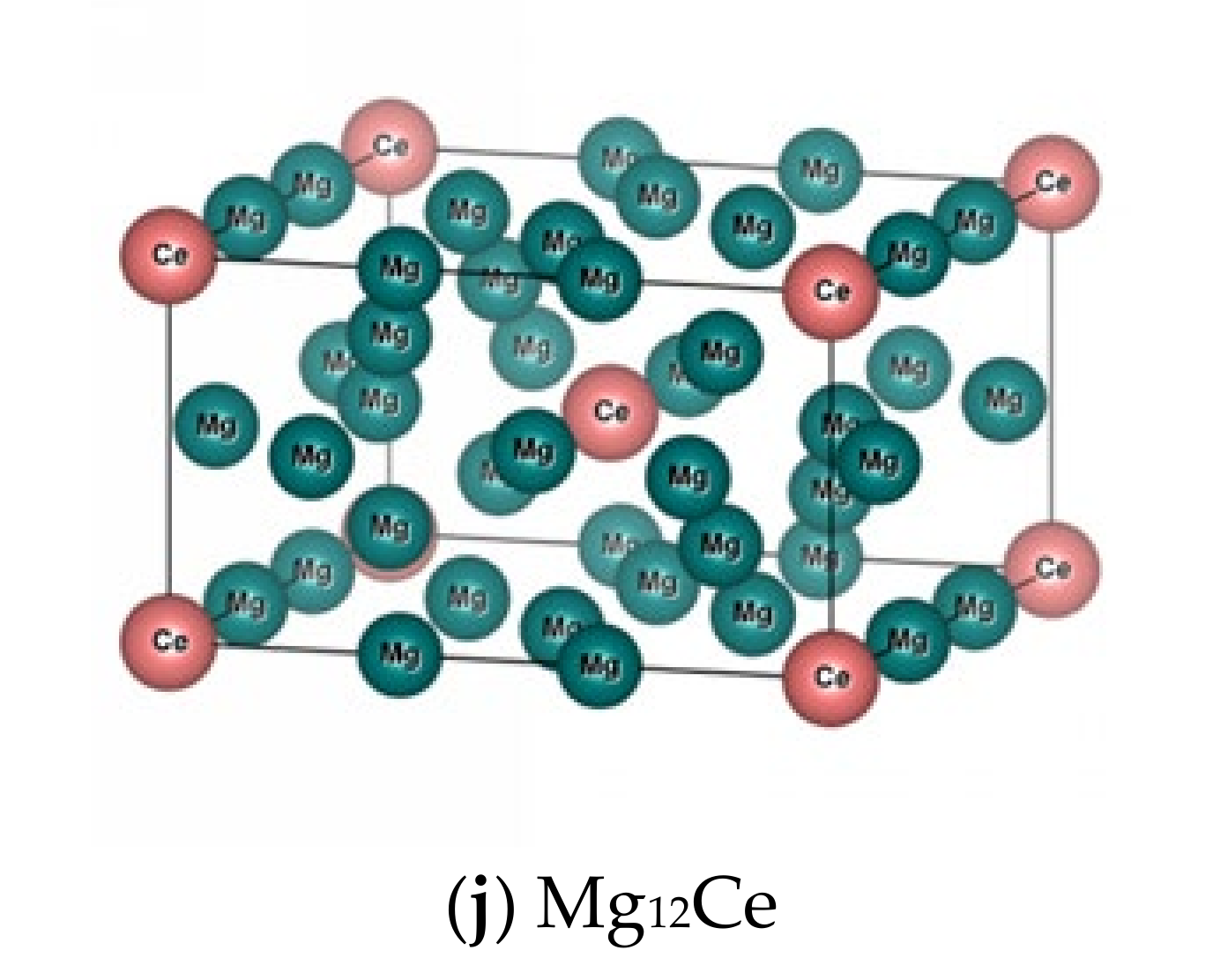
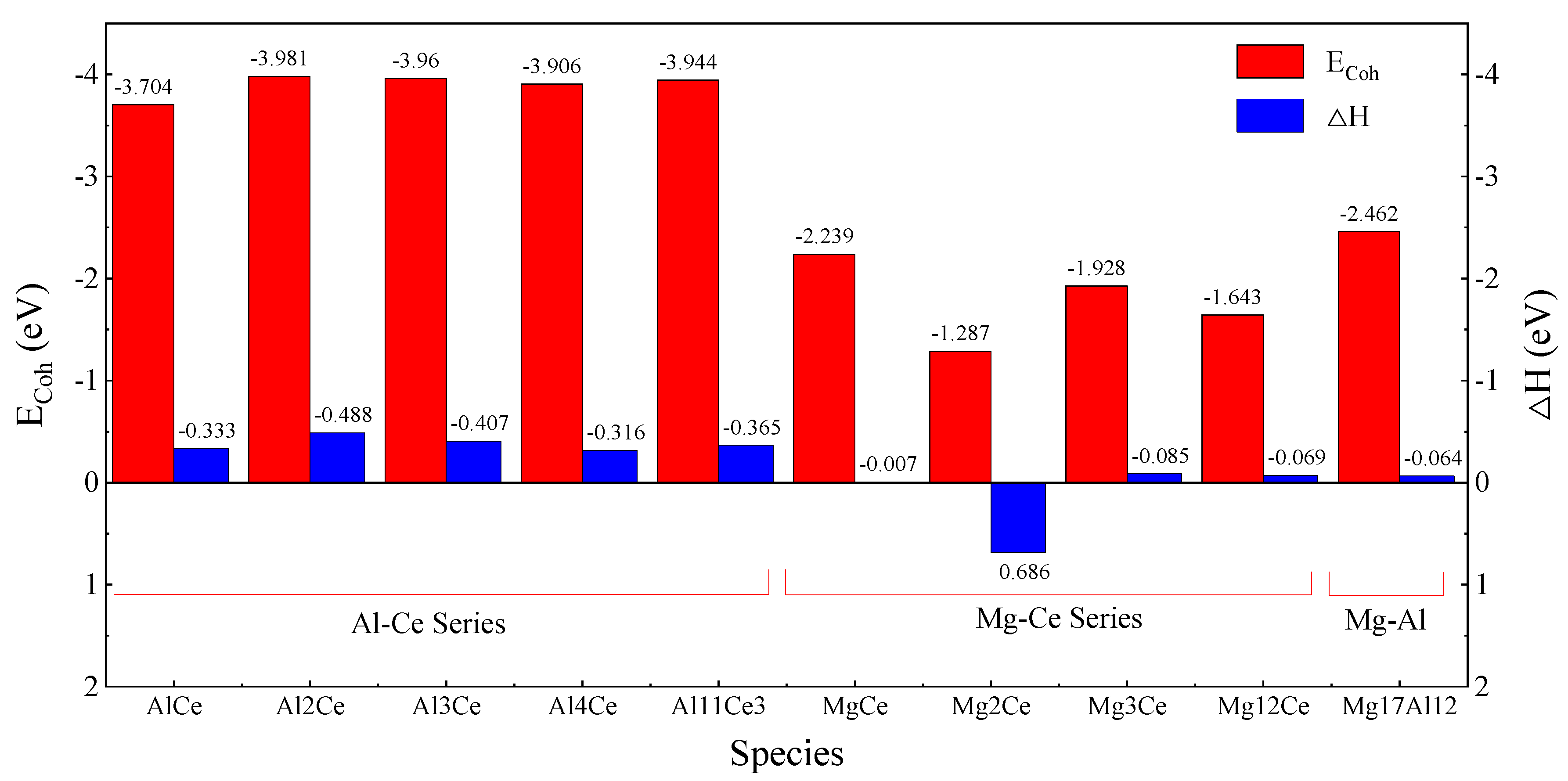
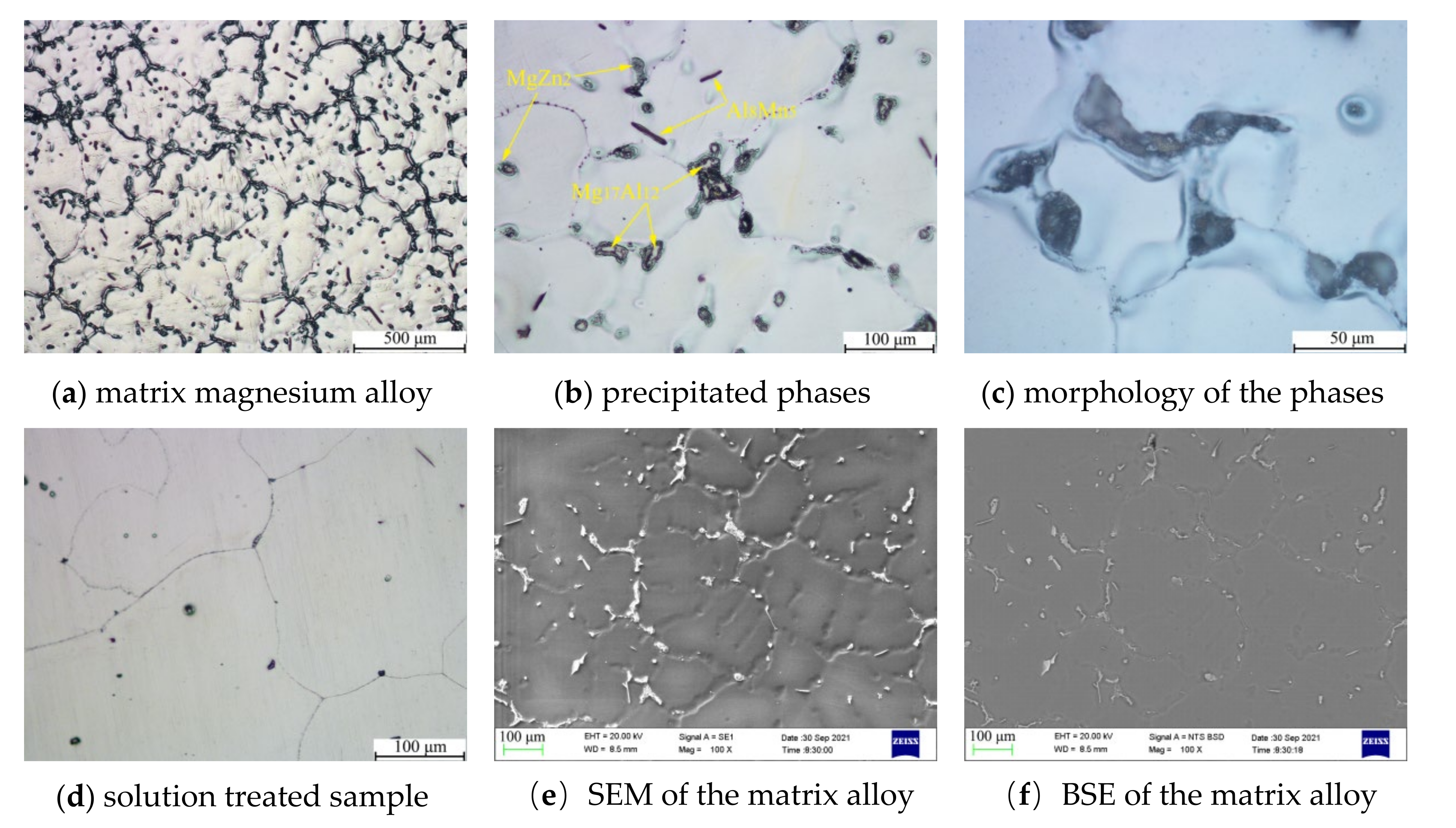

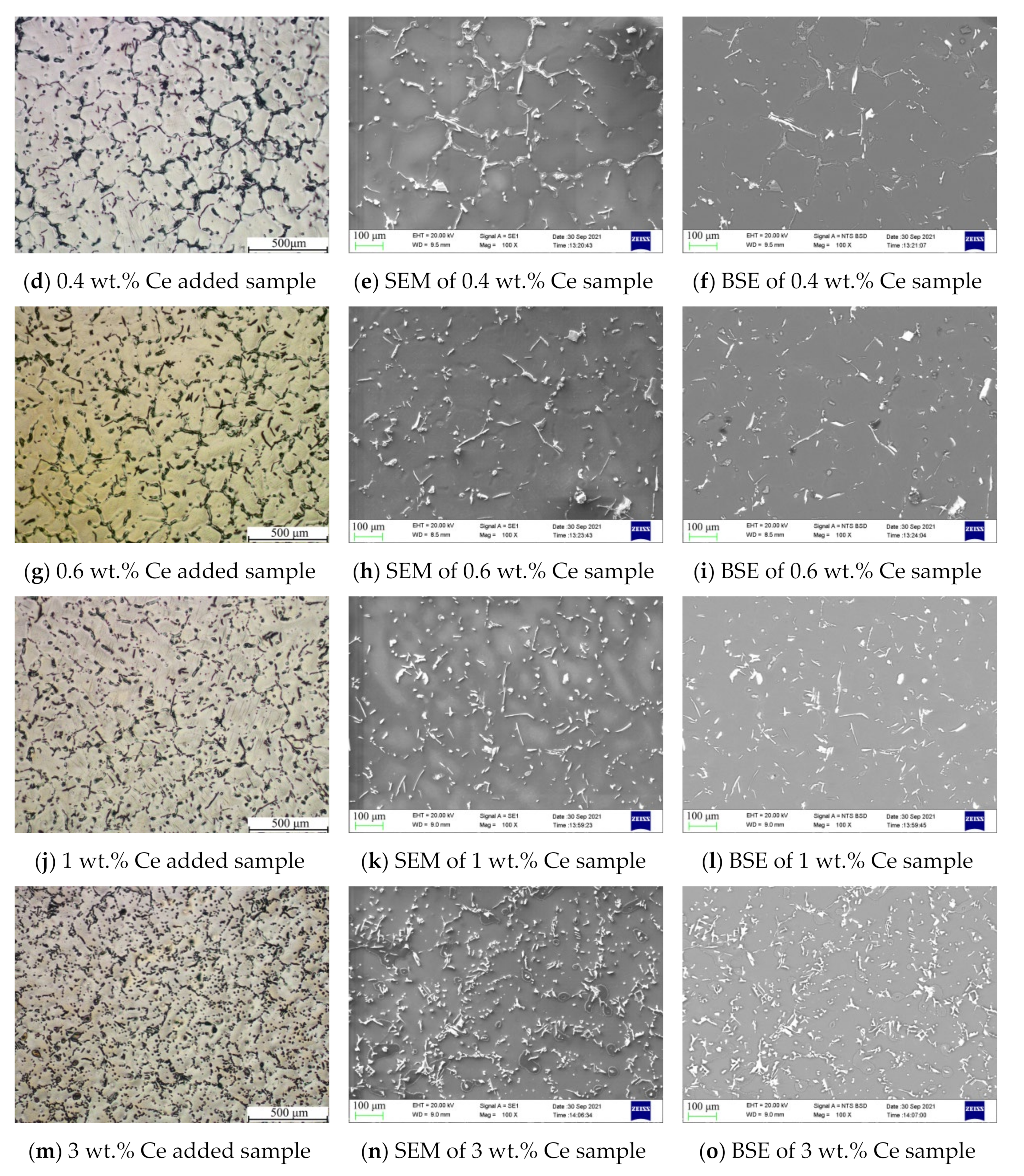
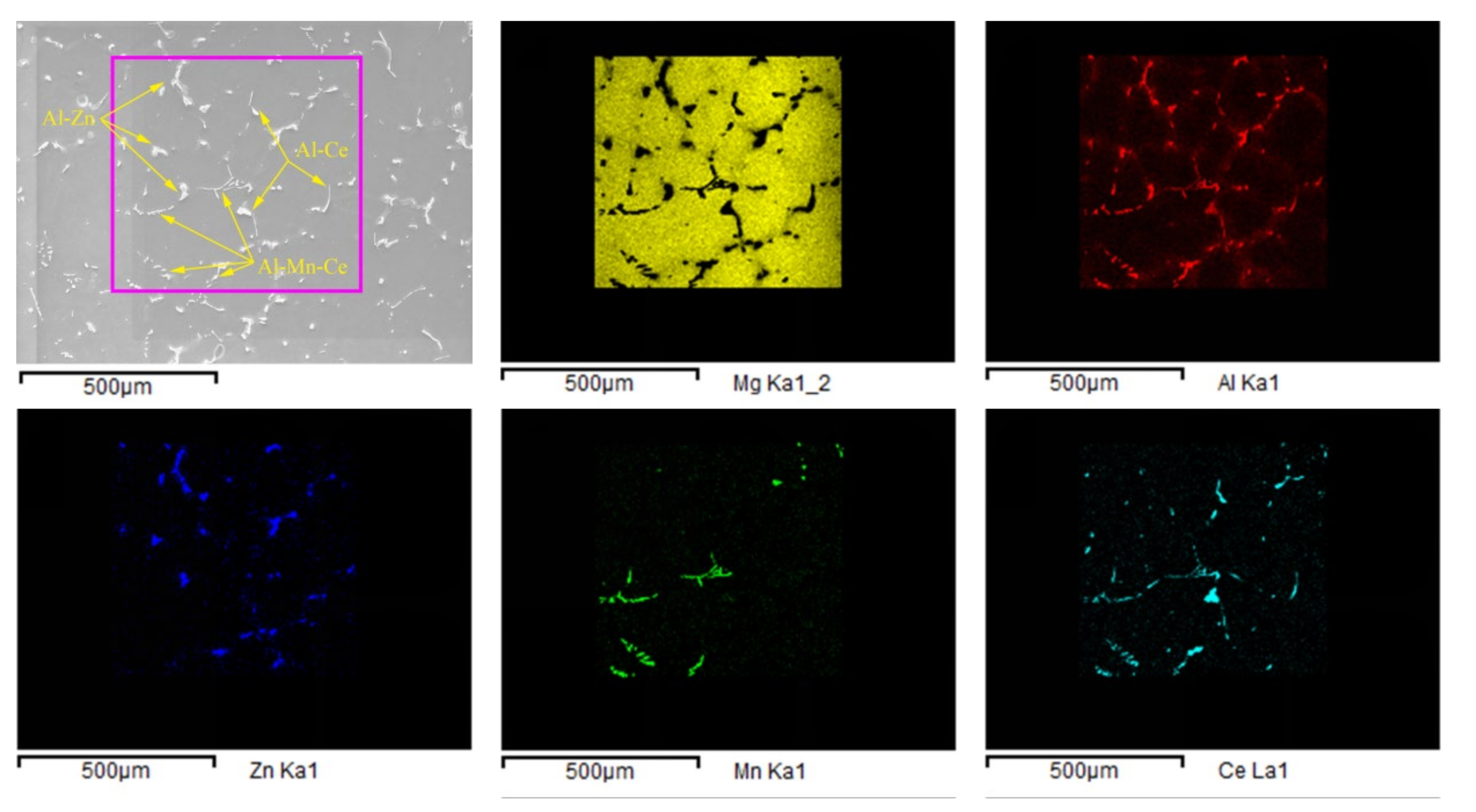

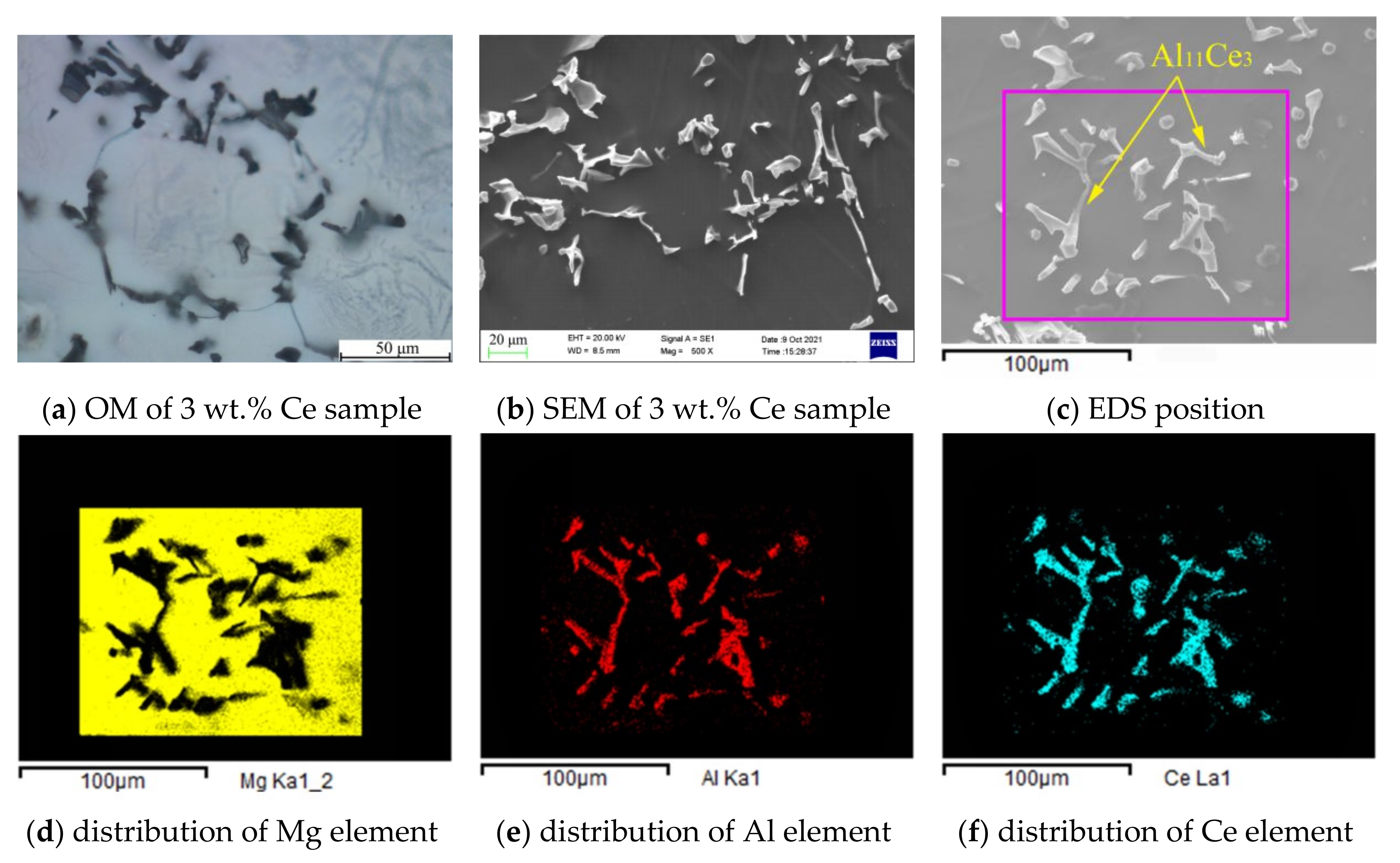


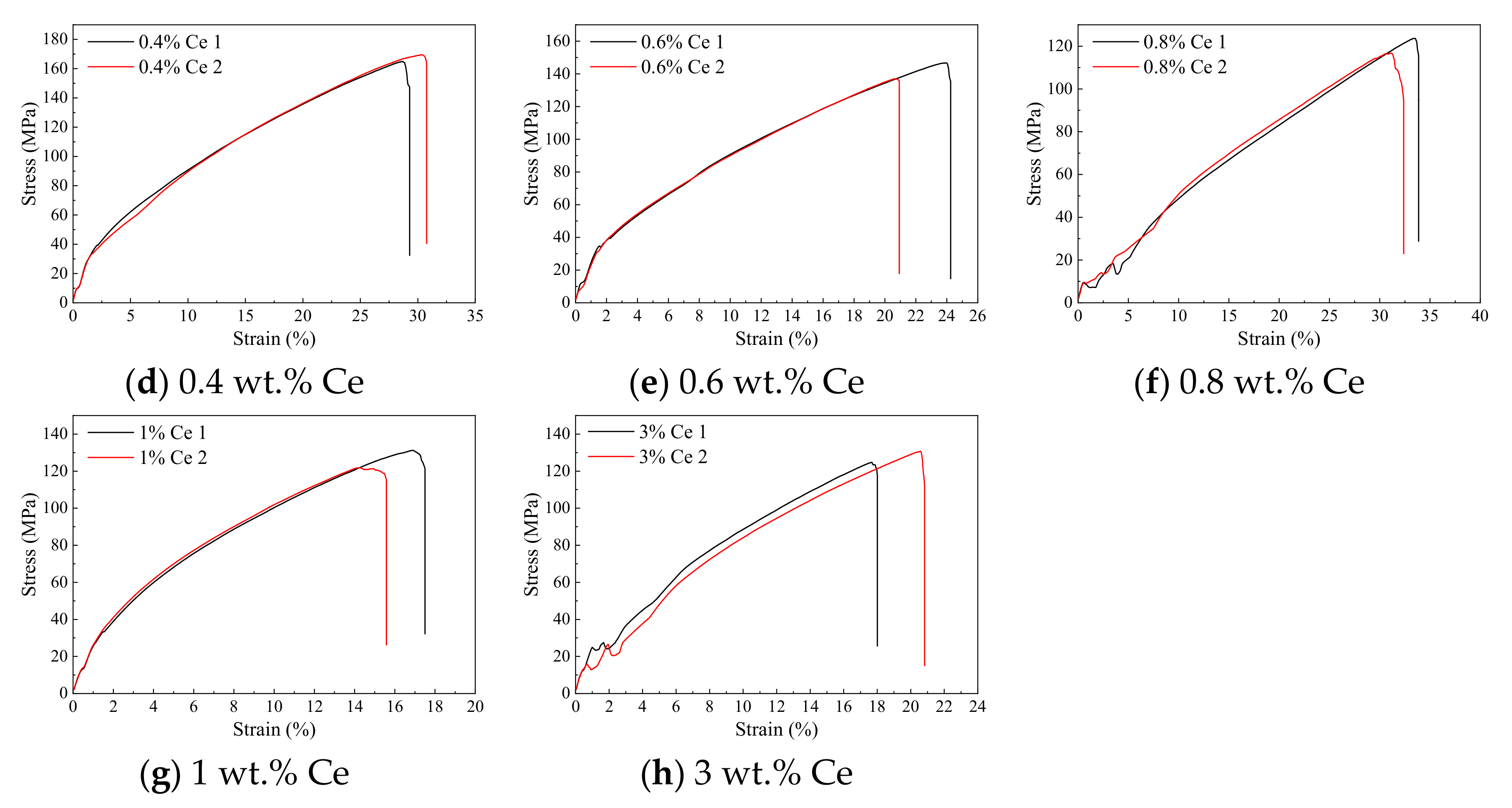

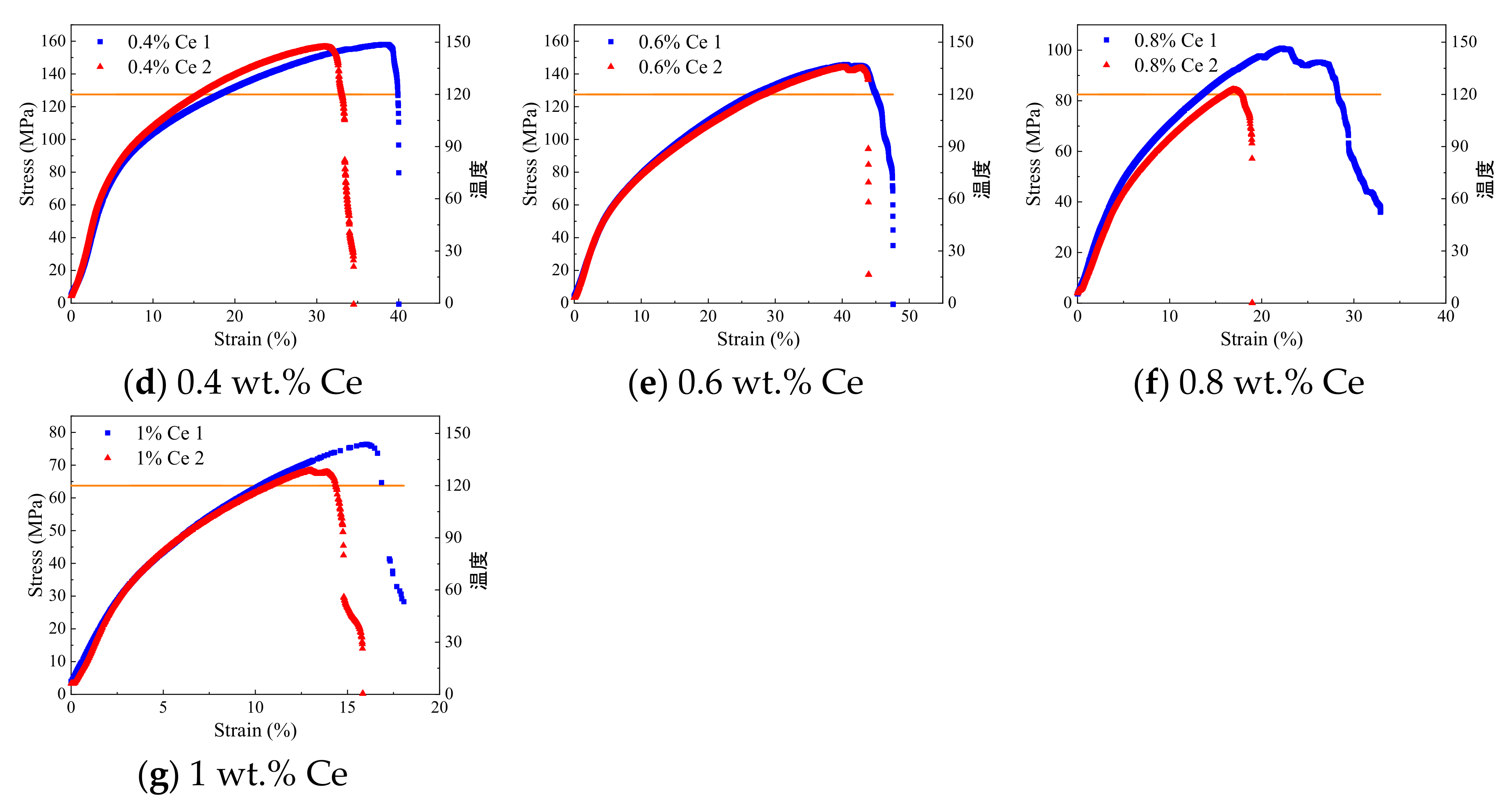
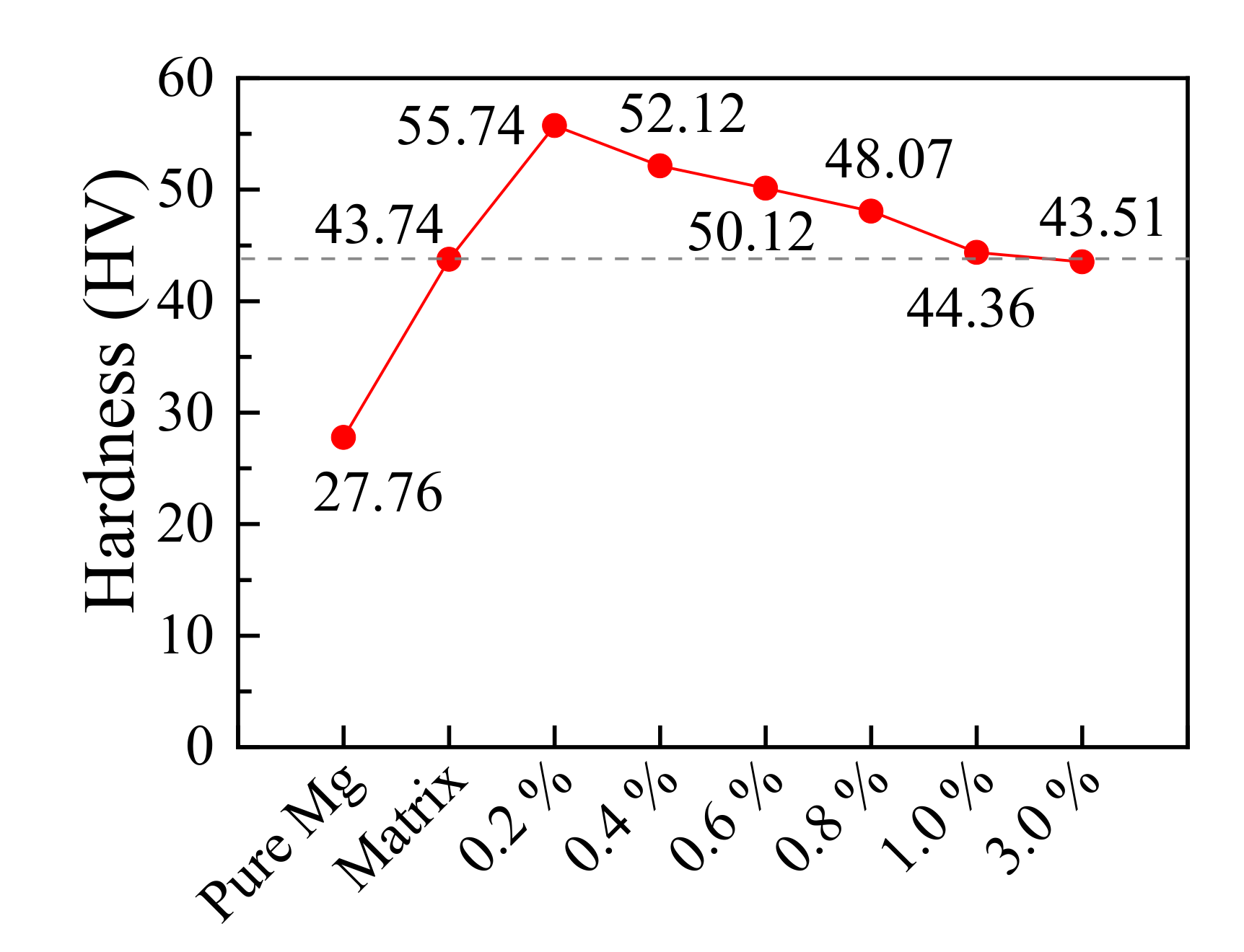
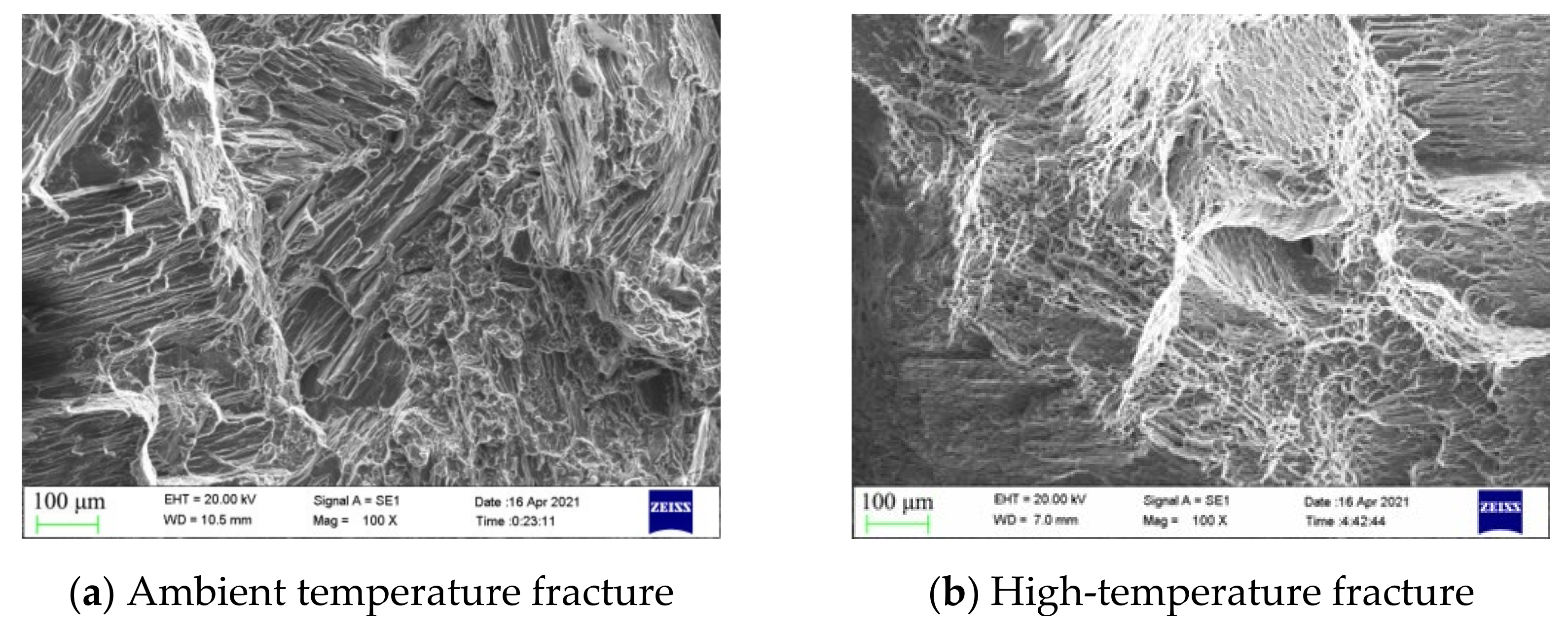
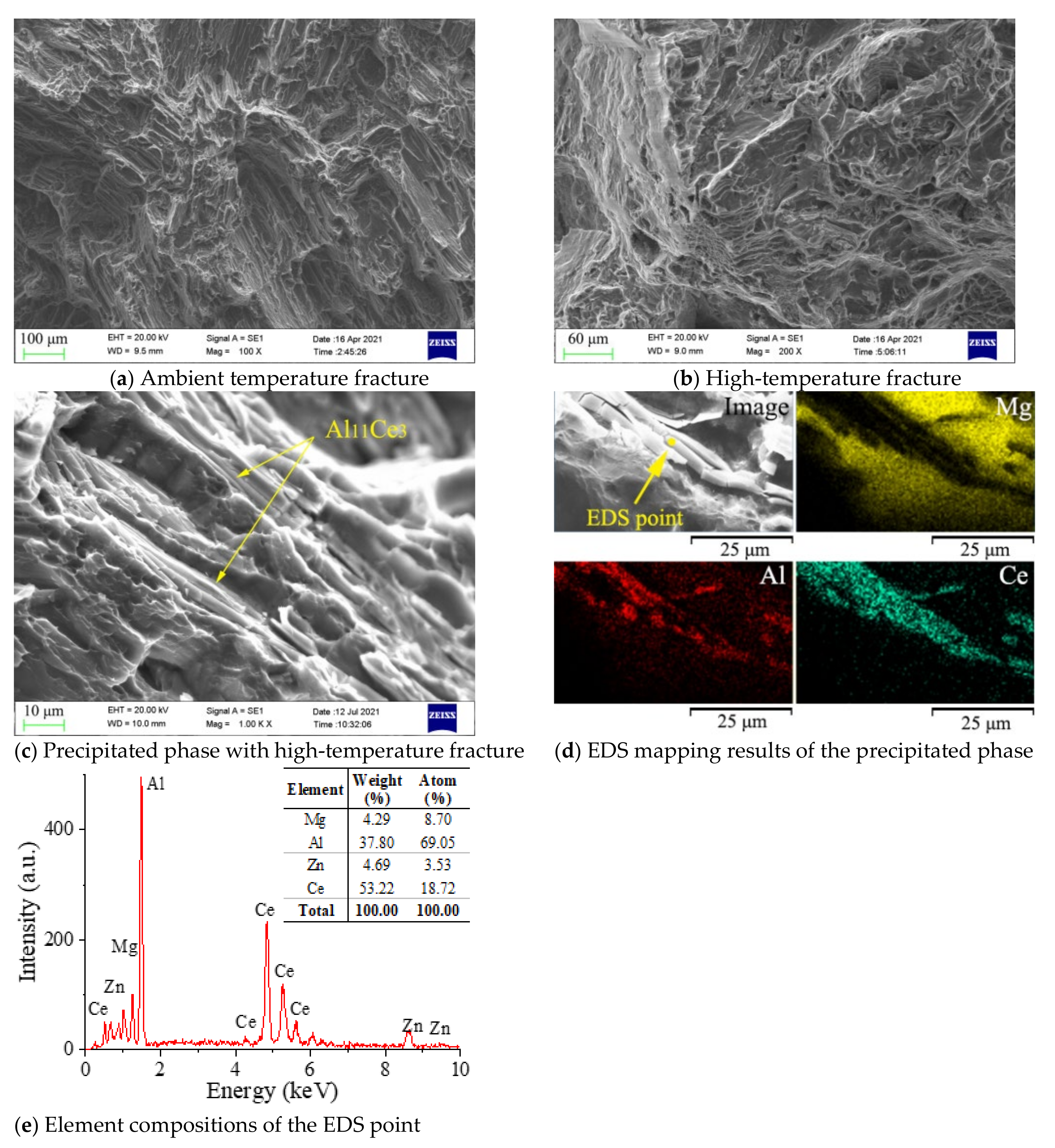

| Elements | Al | Zn | Mn | Si | Fe | Cu | Mg |
|---|---|---|---|---|---|---|---|
| wt.% | 3.156 | 1.098 | 0.385 | 0.167 | 0.029 | 0.014 | Balance |
| Species | AlCe | Al2Ce | Al3Ce | Al4Ce | Al11Ce3 |
| Structure | Pmm | Fdm | P63/mmc | I4/mmm | Immm |
| Space No. | 221 | 227 | 194 | 139 | 71 |
| Species | MgCe | Mg2Ce | Mg3Ce | Mg12Ce | Mg17Al12 |
| Structure | Pmm | Fdm | Fmm | I4/mmm | I3m |
| Space No. | 221 | 227 | 225 | 139 | 217 |
| Species | Mg Atom | Al Atom | Ce Atom | Mg Solid | Al Solid | Ce Solid |
|---|---|---|---|---|---|---|
| EAtom/ESolid (eV) | −52.670 | −972.494 | −1058.339 | −56.404 | −973.949 | −1061.349 |
| Cal. | −52.738 a | −972.226 a | −1058.349 b | −56.420 a | −973.996 a | −1064.147 b |
| Species | AlCe | Al2Ce | Al3Ce | Al4Ce | Al11Ce3 | MgCe | Mg2Ce | Mg3Ce | Mg12Ce | Mg17Al12 |
|---|---|---|---|---|---|---|---|---|---|---|
| △H (eV) | −0.333 | −0.488 | −0.407 | −0.316 | −0.365 | −0.007 | 0.686 | −0.085 | −0.069 | −0.064 |
| Cal. (eV) | −0.337 c | −0.462 c | −0.424 c | −0.302 c | −0.359 c | −0.010 b | 1.311 b | −0.080 b | −0.061 e | −0.053 d |
| ECoh (eV) | −3.704 | −3.981 | −3.960 | −3.906 | −3.944 | −2.239 | −1.287 | −1.928 | −1.643 | −2.462 |
| Cal. (eV) | - | - | - | - | - | −3.059 b | −1.288 b | −2.453 b | - | −2.385 d |
| Species | Pure Mg | 0 wt.% Ce | 0.2wt.% Ce | 0.4 wt.% Ce | 0.6 wt.% Ce | 0.8 wt.% Ce | 1 wt.% Ce | 3 wt.% Ce | |
|---|---|---|---|---|---|---|---|---|---|
| Ambient Temp. | σb (MPa) | 68.2 | 170.3 | 175.2 | 167.2 | 141.8 | 120.2 | 122.5 | 123.7 |
| δ (%) | 11.8 | 11.5 | 54.9 | 29.6 | 22.4 | 32.3 | 16.2 | 19.3 | |
| High Temp. | σb (MPa) | 50.1 | 116.6 | 171.0 | 157.2 | 144.7 | 110.7 | 72.3 | - |
| δ (%) | 38.6 | 39.8 | 41.6 | 36.1 | 44.1 | 23.0 | 15.5 | - | |
| Fd (%) | dMg | |||
|---|---|---|---|---|
| 2.6050 | 2.4520 | 2.7782 | ||
| dAl11Ce3 | 7.9776 | 206.24 | 225.35 | 187.15 |
| 5.0460 | 93.70 | 105.79 | 81.63 | |
| 4.0295 | 54.68 | 64.34 | 45.04 | |
Publisher’s Note: MDPI stays neutral with regard to jurisdictional claims in published maps and institutional affiliations. |
© 2021 by the authors. Licensee MDPI, Basel, Switzerland. This article is an open access article distributed under the terms and conditions of the Creative Commons Attribution (CC BY) license (https://creativecommons.org/licenses/by/4.0/).
Share and Cite
Chen, Y.; Zhu, Z.; Zhou, J.; Lai, H. Study on the Strengthening Mechanism of Rare Earth Ce in Magnesium Alloys, Based on First-Principle Calculations and Electronegativity Theory. Materials 2021, 14, 6681. https://doi.org/10.3390/ma14216681
Chen Y, Zhu Z, Zhou J, Lai H. Study on the Strengthening Mechanism of Rare Earth Ce in Magnesium Alloys, Based on First-Principle Calculations and Electronegativity Theory. Materials. 2021; 14(21):6681. https://doi.org/10.3390/ma14216681
Chicago/Turabian StyleChen, Yanfei, Zhengqiang Zhu, Jixue Zhou, and Huasheng Lai. 2021. "Study on the Strengthening Mechanism of Rare Earth Ce in Magnesium Alloys, Based on First-Principle Calculations and Electronegativity Theory" Materials 14, no. 21: 6681. https://doi.org/10.3390/ma14216681






